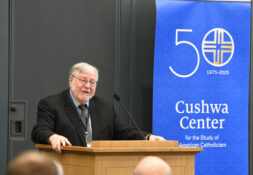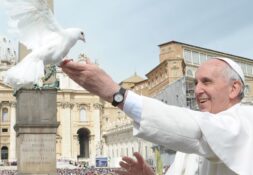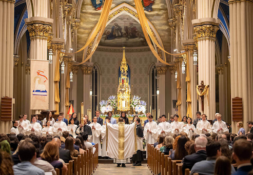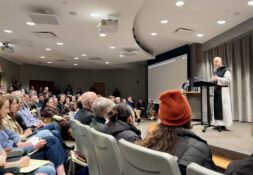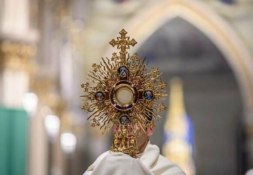Fr. Michael Driscoll, associate theology professor and co-director of the Masters of Sacred Music Program at Notre Dame, kicked off the annual Saturday Scholars lecture series with a talk entitled “Missal Alert: Preparation and Implementation of the New Translation of the Roman Missal.”
Fr. Driscoll provided an overview of the history concerning the Roman Missal and the subsequent translations that occurred after the Second Vatican Council. According to Fr. Driscoll, the new 2011 translation has been in the making since the 1970’s with the International Commission on English in the Liturgy (ICEL).
When provision for the first English translation by ICEL in 1973 was made, Fr. Driscoll explained that it “was really foreseen for missionary countries… no one could foresee [that] the vernacular liturgy would come into play as quickly as it did.” As a result, the first translations of the Roman Missal were done quickly and plans were made to return to these translations decades later.
Before presenting a more in-depth discussion of the history preceding the 2011 translation, Fr. Driscoll discussed the wide range of concerns about and responses to the 2011 translation. Some concerns were that the Church would lose the vision of Vatican II and that the dense, more varied vocabulary of translation is less accessible. Others feared a loss of common Christian texts and expressed a desire to test the new translation in the pews before approving it.
The premier screening of a film made by Notre Dame Theology Professor Margot Fassler expressed some of these concerns. The film included the reactions of students, professors, and faculty, mainly members of the Notre Dame community, including Fr. Peter Rocca, CSC, Steve Warner, Fr. Neil J. Roy, Fr. Anthony Ruff, OSB, and various graduate students.
Some interviewees expressed concern that the Catholic Church’s relationship with other religions would be hurt considering a lack of consultation with Protestants and other religions on the translation. There was also a claim that outside biblical and liturgical scholars were not consulted because Liturgiam Authenticam was pushed by conservative bishops when Pope John Paul II was “ailing and not really in control of things.”
Proponents of the new translation denied these charges. Fr. Driscoll said the new translation was designed to be more theological, more precise, and richer in vocabulary and syntax. Other goals include greater consistency across language groups and that scriptural illusions made in the liturgy were to be made more obvious.
Several key events and movements shaped the 2011 translation. There was a movement for a more literal translation since 1999. ICEL made three international consultations with the English speaking countries of the world and each episcopal conference of bishops was to decide how the translation project was to be completed. American bishops wanted the project to translate the liturgy segment by segment for the next 8 years and then approve the whole project.
Fr. Driscoll explained that even with the 1973 English translation of the Roman Missal, there was already a need for revision and that a new translation was appropriate. This was accompanied by a shift in translators’ foci.
In the past, ICEL consulted Comme le Prevoi by Eugene Nida, a document that argued for the use of dynamic equivalence in translation. It is not a word-for-word translation. Instead, Fr. Driscoll explained that one “tries to capture the genius of the Latin language” and then moves to the target language of English since meaning can get lost in translation.
The Church saw a move to formal correspondence and a more literal translation with the 2001 document of Liturgiam Authenticam, which was concerned with the translation of liturgical texts. In 2003, Blessed Pope John Paul II also spoke about inconsistencies and shadows in translation of the liturgy as he reflected on his experiences of World Youth Day in his encyclical Ecclesia de Eucharistia.
The same year, the Church saw the dedication of the Year to the Holy Eucharist and a synod of bishops called to discuss the liturgy. Pope Benedict XVI summarized this synod in his apostolic exhortation Sacrementum Caritas. Pope Benedict also issued a moto proprio, Summorum Pontificum, concerning the use of the Tridentine Mass and other liturgical practices.
In Advent 2011, the Church will also see changes in the Roman Calendar with the addition of new saints that were canonized in the past decades, new prayers, and greater clarity in language.
Sandra Laguerta is a junior theology major living in Lyons Hall. She loves St. Alphonsus de Liguori, the Little Sisters of the Poor, and peppermints. Contact her at slaguert@nd.edu.
